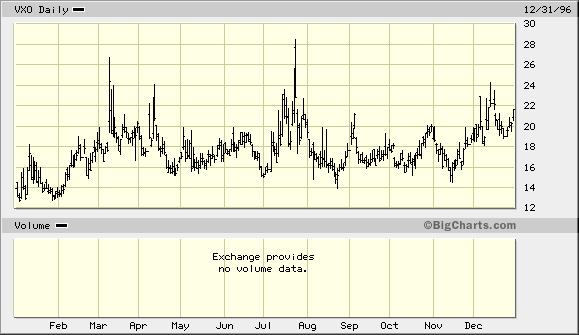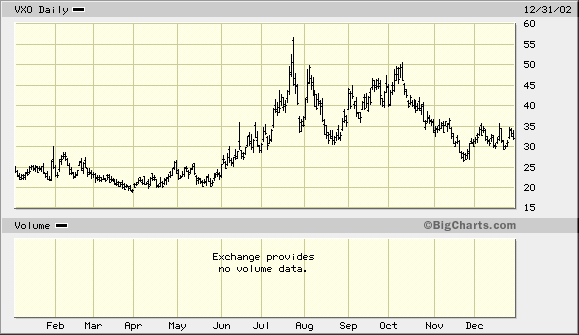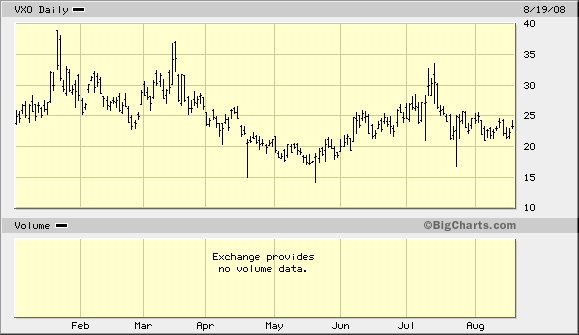Stock Market VIX Volatility and the 6 Year Cycle
Stock-Markets / Volatility Aug 21, 2008 - 08:19 AM GMTBy: Clif_Droke
 Volatility tends to run very high during years in which the Kress 6-year cycle is bottoming. Volatility has indeed been a major factor this year and it has been years since we've seen it as high this year. As I'll attempt to show you here, this increased volatility can be ascribed to the influence of the 6-year cycle which has been “hard down” this year and is due to bottom in later September.
Volatility tends to run very high during years in which the Kress 6-year cycle is bottoming. Volatility has indeed been a major factor this year and it has been years since we've seen it as high this year. As I'll attempt to show you here, this increased volatility can be ascribed to the influence of the 6-year cycle which has been “hard down” this year and is due to bottom in later September.
The 6-year cycle tends to have a deflationary impact on financial assets, especially stocks and real estate. This has been reflected in the weak real estate market as well as the bear market in stocks this year. The S&P has been a victim of the 6-year cycle-related volatility as money has rotated from stocks to commodities and back again throughout the year. The wild merry-go-round ride that this volatility has inflicted on traders isn't over just yet, though it should be ending in just a matter of weeks.
Looking back at previous years in which the 6-year cycle has bottomed we see a similar pattern of abnormally high volatility. For instance, the year 1996 was a 6-year cycle bottom year. Notice in the following chart, which shows the CBOE Market Volatility Index (VXO), that in 1996 stock market volatility spiked a reading of 24 or above four times during the year. At the time, this was considered extremely high volatility.

The next 6-year cycle bottom was in 2002, which was also one of the worst bear market years for stocks since the 40-year cycle bottom in 1974. It wasn't only the 6-year cycle that bottomed in late 2002, but also the 4-year and 12-year cycles. The combined influence of these cycles created a strong downward bias in the stock market and led to a 40% decline in the S&P 500 from its bull market high a couple of years earlier.
Volatility in 2002 ran exceptionally high as measured by the Volatility Index. The VXO spiked from a baseline reading of 20 to a multi-year high of 57 in July 2002 as the S&P was making its internal low. Market volatility then fell to about 30 as measured by VXO, then spike one last time to the 50 level in early October as the 4-year/6-year/12-year cycle made its final bottom. From there, volatility steadily diminished and fell below 30 in late November.

Investors haven't been exempted in 2008 from the volatility that normally makes its appearance during 6-year cycle bottom years. While the overall level of volatility this year hasn't been as high as that of the previous 6-year cycle bottom in 2002, this year has definitely seen its fair share of volatility spikes.
The volatility trend this year has run extremely high, which is par for the course since the 6-year cycle is scheduled to bottom in late September. Already this year there have been three spikes in market volatility as measured by the VXO: one in January, one in March and another in July. Each of these spikes has corresponded with a major low in the S&P 500 index. Notice the pattern of declining tops in these volatility spikes. This shows that while volatility is still lively at times as we head closer to the final 6-year cycle low, the magnitude of the spikes is diminishing. This could be interpreted as a sign that selling power is losing its conviction; however, there is one important caveat to this observation. Until the final 6-year cycle bottom is in -- which is less than six weeks from now -- there can always be a final spike in volatility that breaks this downward trend and a corresponding move lower in the S&P. The 6-year cycle bottom still must be reconciled.

The volatility generated by the latest 6-year cycle has inspired a sector rotation strategy for the hedge funds. As soon as the S&P shows any weakness the funds run into oil and commodity stocks, but once the S&P reverses and shows any kind of strength they run back into stocks and abandon commodities. Although this “sector rotation volatility” is common in years when the 6-year cycle is bottoming, it has been more severe in 2008 than in previous 6-year cycle bottom years and can be expected to continue until the 6-year cycle is completely behind us.
As discussed in my recent article, “Crude oil and the 6-year cycle,” the years in which the 6-year cycle bottoms tends to have a depressing effect on stocks while at the same time having a lifting effect on oil and other key commodities. We've seen record oil prices in 2008, no doubt due (at least partly) to the influence of the 6-year cycle. The run-up in the price of crude and other commodities during times when the stock market was declining has been exacerbated by the growing influence of hedge funds, whose flexibility enables them to jump in and out of major sectors. This has a direct impact on market volatility and explains the yo-yo effect we've seen in the prices of stocks and commodities in the past several months. Until the 6-year cycle bottom is finally and fully behind us, the market will still be vulnerable to this volatility at times.
The good news is that the volatility that has characterized the year 2008 to date should soon be dissipating and a smoother stock market course should be ahead of us once the 6-year cycle bottoms in late September. Virtually every week this year has seen at least one of the weekly cycles peaking and/or bottoming in a continuous succession. With this many cross-currents, it's little wonder the market has had a difficult time achieving a smooth directional flow. Once we get past the 6-year bottom, however, volatility should stabilize and become less of a factor as the cycles finally allow for a relatively smoother, sustainable rally into 2009 until the 10-year cycle peaks next summer.
By Clif Droke
www.clifdroke.com
Clif Droke is the editor of the daily Gold & Silver Stock Report. Published daily since 2002, the report provides forecasts and analysis of the leading gold, silver, uranium and energy stocks from a short-term technical standpoint. He is also the author of numerous books, including 'How to Read Chart Patterns for Greater Profits.' For more information visit www.clifdroke.com
Clif Droke Archive |
© 2005-2022 http://www.MarketOracle.co.uk - The Market Oracle is a FREE Daily Financial Markets Analysis & Forecasting online publication.



